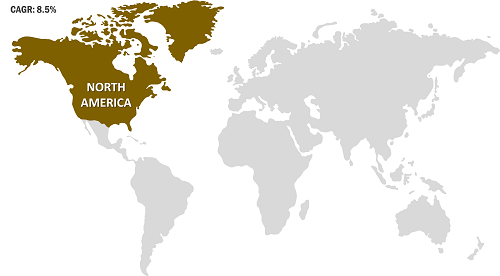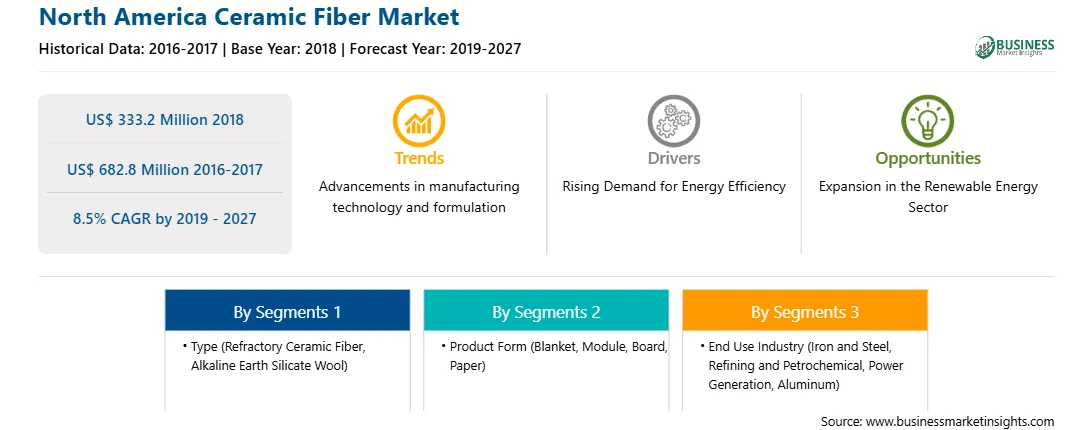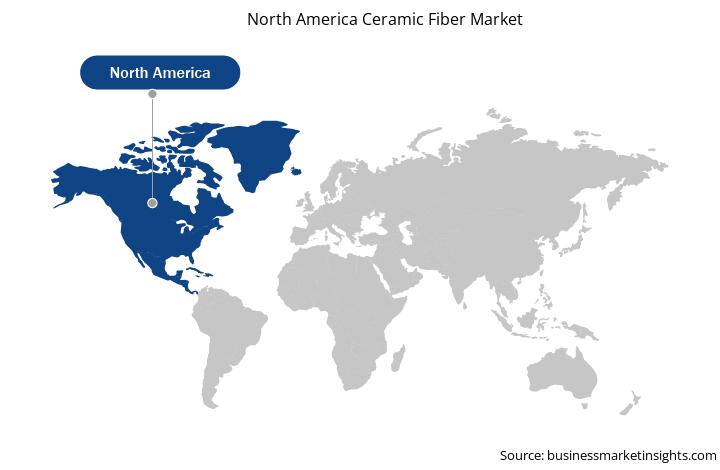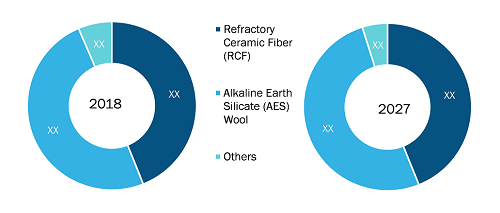In 2018, The US is dominating the North America ceramic fiber market, followed by Canada. The power generation sector is an important consumer of ceramic fiber due to its wide utilization of insulation. In commercial fire protection, ceramic fibers are used in grease-duct insulation and penetration and expansion-joint seals. Ceramic fiber products are used in refractories for high-temperature equipment that is used in ceramic production. This equipment includes blast furnaces, hot stoves, steam boilers, cement kilns, glass tanks, and open-hearth furnaces. The wide application of ceramic fiber is boosting demand in the US.

Strategic insights for the North America Ceramic Fiber provides data-driven analysis of the industry landscape, including current trends, key players, and regional nuances. These insights offer actionable recommendations, enabling readers to differentiate themselves from competitors by identifying untapped segments or developing unique value propositions. Leveraging data analytics, these insights help industry players anticipate the market shifts, whether investors, manufacturers, or other stakeholders. A future-oriented perspective is essential, helping stakeholders anticipate market shifts and position themselves for long-term success in this dynamic region. Ultimately, effective strategic insights empower readers to make informed decisions that drive profitability and achieve their business objectives within the market.

| Report Attribute | Details |
|---|---|
| Market size in 2018 | US$ 333.2 Million |
| Market Size by 2027 | US$ 682.8 Million |
| CAGR (2019 - 2027) | 8.5% |
| Historical Data | 2016-2017 |
| Forecast period | 2019-2027 |
| Segments Covered |
By Type
|
| Regions and Countries Covered | North America
|
| Market leaders and key company profiles |
|
The geographic scope of the North America Ceramic Fiber refers to the specific areas in which a business operates and competes. Understanding local distinctions, such as diverse consumer preferences (e.g., demand for specific plug types or battery backup durations), varying economic conditions, and regulatory environments, is crucial for tailoring strategies to specific markets. Businesses can expand their reach by identifying underserved areas or adapting their offerings to meet local demands. A clear market focus allows for more effective resource allocation, targeted marketing campaigns, and better positioning against local competitors, ultimately driving growth in those targeted areas.

The lightweight of ceramic fiber is an essential feature that weighs about one-tenth as compared to insulating brick and one third than that of calcium silicate or asbestos boards. For new constructions, the structural supports can be reduced to approximately 40% with the help of ceramic fibers. Another important feature that has been responsible for the increasing demand from the end-users is lower heat storage. Due to its lower density, ceramic fiber absorbs less heat due to which the furnaces can be heated and cooled at much faster rates. Thermal shock resistance is another contributing factor for the increasing demand for ceramic fiber market. Due to its resilient matrix, ceramic fiber linings are capable of resisting thermal shock. All these properties of ceramic fiber have been contributing to the growing demand for ceramic fiber from various end-use industries like iron and steel, refining and petrochemical, power generation, aluminum, and others.
Based on type, the North America ceramic fiber market is bifurcated as Refractory Ceramic Fiber (RCF), Alkaline Earth Silicate (AES) wool, and others. The RCF segment holds the largest share in the North America ceramic fiber market. RCFs are manufactured in various forms, such as bulk fiber, blanket, modules, felt, paper, and vacuum formed shapes. Products made of RCF products are used in industrial equipment, fire protection, and automotive exhaust systems. Refractory ceramic fiber (RCF) has been recognized as the first-choice material in several end-use industries. They are easy to handle and possess low thermal conductivity and heat capacity. Apart from this, they possess superior resistance to thermal shock and pollutants; and can withstand extreme temperatures. Such qualities of RCF make it a viable product for numerous applications. They are mainly used as a lining material for kilns and furnaces and as an insulator for the outside of the ceramic molds. They are also extensively used for insulation in condensing boilers and as the sealing material in various industries such as mechanical, metallurgical, power, and chemical industries.
Based on product form, the North America ceramic fiber market is bifurcated as a blanket, module, board, paper, and others. The blanket segment dominated the North America ceramic fiber market. Blankets find their applications in a number of industries which incorporates temperatures from 1000°F (538°C) to 2600°F (1425°C). They are also used in petrochemical, steel, ceramic, and power generation as heat shields, seals and gaskets, pipe and ducting wrap, steam turbine insulation, pipe insulation, exhaust lining, fire protection systems amongst others. Ceramic fiber blankest offers resistance to thermal shock and oxidizing and exhibits low thermal conductivity and heat storage along with good dielectric strength, superior resiliency, non-combustibility, and sound absorption.
The North America Ceramic fiber market is bifurcated based on the end-use industry into iron and steel, refining and petrochemical, power generation, aluminum, and others. The refining and petrochemical segment accounted for the largest share in the North America ceramic fiber market. Ceramic fibers possess several properties, such as lightweight, resistance to thermal shock, chemical & corrosion, low thermal conductivity, and high-temperature stability. Also, low operational costs, high reliability, and less energy requirement associated with the use of ceramic fiber in furnace linings, roofs, and walls are boosting its usage across the refining and petrochemical industry.

Strategic insights for the North America Ceramic Fiber provides data-driven analysis of the industry landscape, including current trends, key players, and regional nuances. These insights offer actionable recommendations, enabling readers to differentiate themselves from competitors by identifying untapped segments or developing unique value propositions. Leveraging data analytics, these insights help industry players anticipate the market shifts, whether investors, manufacturers, or other stakeholders. A future-oriented perspective is essential, helping stakeholders anticipate market shifts and position themselves for long-term success in this dynamic region. Ultimately, effective strategic insights empower readers to make informed decisions that drive profitability and achieve their business objectives within the market.

| Report Attribute | Details |
|---|---|
| Market size in 2018 | US$ 333.2 Million |
| Market Size by 2027 | US$ 682.8 Million |
| CAGR (2019 - 2027) | 8.5% |
| Historical Data | 2016-2017 |
| Forecast period | 2019-2027 |
| Segments Covered |
By Type
|
| Regions and Countries Covered | North America
|
| Market leaders and key company profiles |
|
The geographic scope of the North America Ceramic Fiber refers to the specific areas in which a business operates and competes. Understanding local distinctions, such as diverse consumer preferences (e.g., demand for specific plug types or battery backup durations), varying economic conditions, and regulatory environments, is crucial for tailoring strategies to specific markets. Businesses can expand their reach by identifying underserved areas or adapting their offerings to meet local demands. A clear market focus allows for more effective resource allocation, targeted marketing campaigns, and better positioning against local competitors, ultimately driving growth in those targeted areas.

The List of Companies - North America Ceramic Fiber Market
The North America Ceramic Fiber Market is valued at US$ 333.2 Million in 2018, it is projected to reach US$ 682.8 Million by 2027.
As per our report North America Ceramic Fiber Market, the market size is valued at US$ 333.2 Million in 2018, projecting it to reach US$ 682.8 Million by 2027. This translates to a CAGR of approximately 8.5% during the forecast period.
The North America Ceramic Fiber Market report typically cover these key segments-
The historic period, base year, and forecast period can vary slightly depending on the specific market research report. However, for the North America Ceramic Fiber Market report:
The North America Ceramic Fiber Market is populated by several key players, each contributing to its growth and innovation. Some of the major players include:
The North America Ceramic Fiber Market report is valuable for diverse stakeholders, including:
Essentially, anyone involved in or considering involvement in the North America Ceramic Fiber Market value chain can benefit from the information contained in a comprehensive market report.